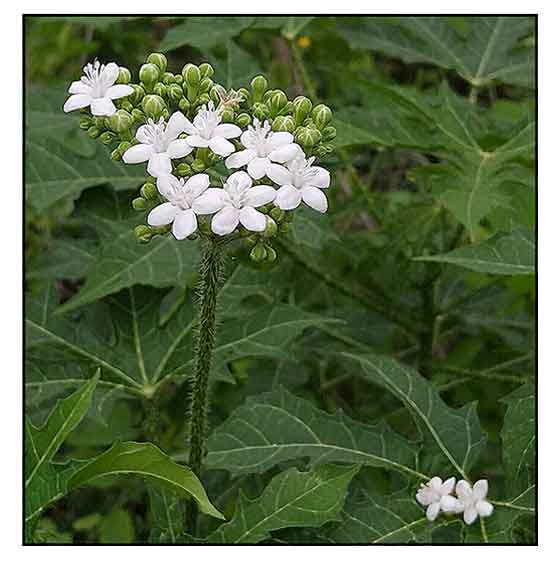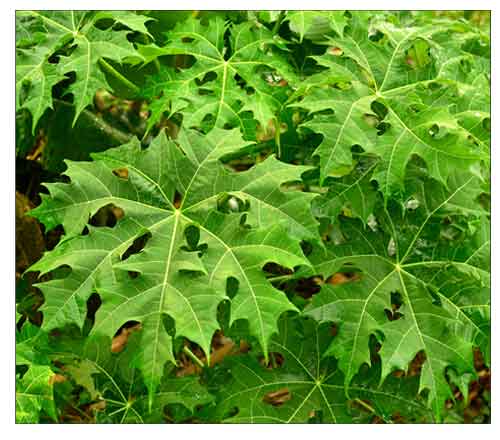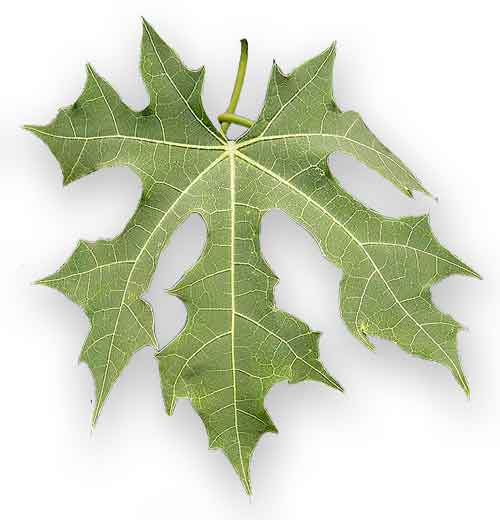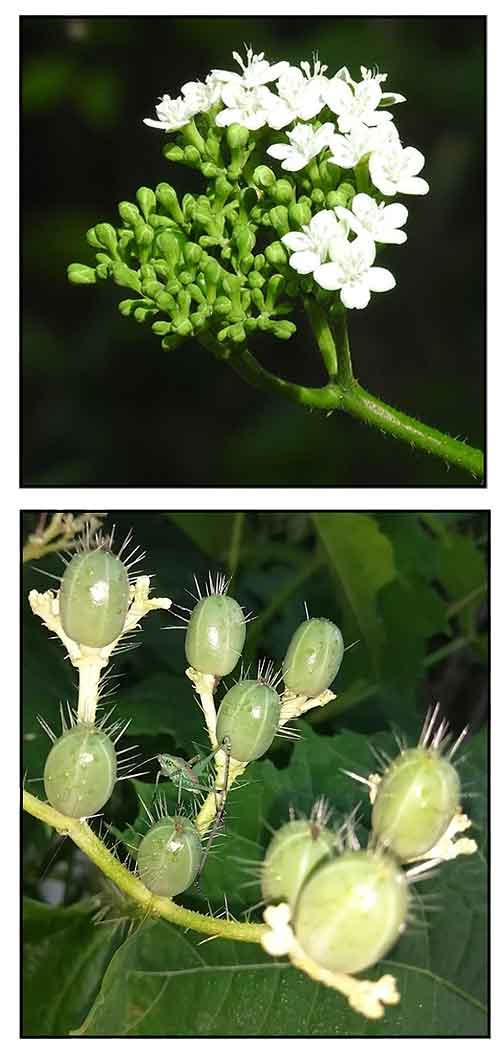 Gen info Gen info
- Cnidoscolus is a genus of plants in the family Euphorbiaceae, which was erected in 1827.
- The genus was established by Johann Pohl in 1827 to include species characterized by a single whorl in the perianth and the presence of stinging trichomes across nearly all vegetative and floral parts.
(13)
-
Cnidoscolus aconitifolius, commonly known as chaya tree or spinach tree, is a large, fast-growing and leafy perennial shrub believed to have originated in Yucatan Peninsula of southeastern Mexico. (3)
- Etymology: The genus name Cnidoscolus derives from Greek words knide, meaning "nettle", and skolops, meaning "thorn" or "prickle". (4) The specific epithet, aconitifolius, refers to the plant's Aconitum-like leaves, coincidentally, another well-known dangerous, even deadly, genus of plants. (3)
-
Chaya is one of the most productive green vegetables. It has two to three times more nutrients than spinach, Chinese cabbage, and lettuce.
 Botany Botany
• C. aconitifolius is shrubby to small tree, up to 4 m high, with milky latex. Terete trunk, with large scars; bark fawn, cracked, with milky latex. Glossy green branches, white patches, with or without stinging hairs. Stipules narrow lanceolate, 2-3 × 1 mm, apex acuminate, brown, early caducous. Leaves simple, alternate with slender petioles, 5.5–28 cm long, green, glabrous; lamina 3- lobed or 5–7(–9)-partitioned, 6–23 × 7–30 cm; dark green above, yellowish green below, sub-coriaceous; Nectar glands are present at the base. flower terminal, dichasial sub-umbelliform; stalks up to 29 cm long with few short pilose hairs, green; triangular-linear bracts and bracteoles. Stamina salverform flower, congenital sepal petaloid, 5-lobed; tube 6-10 mm long, green; obovate to orbicular lobe, 3-4 × 4-5 mm, white, green below; stamens 10, 2- coiled, outer stamens 4 mm long; inner stamen length 7 mm; filiform filaments, white; anthers oblong, 1-2 × 0.5-1 mm, white, dorsibasifixation; Pistillode present, stringy, white. Pistil campanulate flowers, petaloid 5 petals, free, lobes oblong, 6–7 × 3 mm, white; 5-lobed disc, glabrous, white; ovary superior, ellipsoid, 3 mm long, triloculate, glossy green, glabrous; very short force, ±1 mm; stigma forked, white, glabrous. Fruit capsule, unbroken, ovoid, 1, × 0.6cm. Seeds fail. (17)
Distribution
- Introduced and cultivated as a vegetable in the Philippines.
-
Naturalized near Cebu City. (2)
- Native to Belize, Costa Rica, El Salvador, Guatemala, Honduras, Mexico Central, Mexico Gulf, Mexico Northeast, Mexico Southeast, Mexico Southwest, Nicaragua, Panamá. (1)
 Constituents Constituents
- Phytochemical screening of ethanolic extract of leaves revealed abundant levels of alkaloids and flavonoids, with moderate levels of tannins. Extract yielded 6.0% crude protein, 37% crude fiber, 5.0% crude fat, 3.0% ash, and 8.1% muslin. Mineral composition per gram extract yielded 13 mg iron, 95 mg phosphorus, 0.03 mg sodium, 89 mg magnesium, 22 mg potassium, 16 mg manganese, and 55 mg calcium. (see study below) (6)
- C. aconitifolius ethyl acetate extract yielded total flavonoids of 154.23 mg QE/ml. (see study below) (7)
- Phytochemical screening of leaves revealed presence of
lunamarine, cardiac glycoside, anthocyanin, spartien, cyanogenic glycoside, flavonones, steroids, keampferol, epicatechin, flavones, oxalate, resveratol, sapogenin, epihedrine, flavan-3-ol, proanthocyanin, naringin, ribalinidine, naringenin, catechin, tannin, rutin, and phytate.
The ethanol extract recorded phytate (18.92 µg/ml) as highest yield; the methanol extract, spartein (17.20 µg/ml), and aqueous extract, epicatechin (9.24 µg/ml). (16)
- Nutrient composition of fresh chaya leaves (Cnidoscolus aconitifolius ssp. aconitifolius Breckon) per 100g:
(g) Moisture 80, protein 7.20, fat 0.09, crude fiber 2.20, total carbohydrates 6.70; (mg) calcium 324, phosphorus 76.0, iron 5.60, retinol equivalents 946.00, thiamin 0.24, riboflavin 0.35, niacin 1.60, ascorbic acid 235.00; energy 57kcal. (29)
Toxicity
-
Like most euphorbias, the entire plant contains a caustic, viscous, and potentially dangerous white sap, which flows readily when any part of the plant is broken, cut, or damaged. Avoid contact of an raw plant material (sap, juice, raw leaves) into one's mucous membranes i.e., mouth, eyes, genitals, nose, inner ears, open wounds, etc. Contact may cause symptoms ranging from simple irritation to burning pain, temporary blindness, loss of smell or taste. (3)
- Some varieties have stinging hairs and gloves are required for harvesting. Raw leaves are toxic, a source of glucoside that can release toxic cyanide. Cooking is essential prior to consumption to inactivate the toxic compounds. Cooking in aluminum utensils may produce a toxic broth, causing diarrhea. (3)
- Traditionally, leaves are immersed and simmered for 20 minutes, then served with oil or butter. Cooking for 20 minutes or more renders the leaves safe to eat. The leaf stock and liquid may be safe for consumption as the cyanide is volatilized as hydrogen cyanide (HCN) during cooking. (3)
- Four known cultivars: Picuda, Estrella, Chayamansa, and Redonda do have many urticating hairs compared to other cultivars and wild types, and are more acceptable for culinary use. (3)
Properties
-
Studies have suggested nephroprotective, antioxidant, antidiabetic, anti-inflammatory, sedative-hypnotic, antidepressant, gastroprotective, immunomodulatory, triglyceride lowering, antihypertensive, cardiorenal function enhancing, pesticidal, antibacterial, ACE-inhibitory, α-glucosidase and α-amylase inhibitory, anti-methanogen, antithrombotic, anti-candidal, hepatoprotective properties.
Parts used
Leaves.
 Uses
Uses
Edibility
- Leaves should always be cooked before consumption. Raw leaves contain a high amount of toxic hydrocyanic acid, in addition to the irritating sap typical of Euphorbiaceae family members. While reportedly raw-edible in small amounts (2-5 leaves), cooking is always advised. Required cooking time is 5-15 minutes for leaves, with most recipes recommending 20 minutes. Also advised: avoid cooking in aluminum cookware because of the "malleable" soft nature of aluminum and the corrosive nature of the plant's innate alkaloids. (3)
- Young chaya leaves and thick, tender stem tips, cut and boiled as a spinach, is a tasty vegetable, exceptionally high in protein, calcium, iron, and vitamin A. Chaya leaf nutrients are 2- to 3-fold greater than any other land-based leafy green vegetable. (3)
Folkloric
- No reported folkloric medicinal use in the Philippines.
-
In Nigeria, leaves used for treatment of CNS related disorders such as convulsion or anxiety. (8)
- In Mexico, used for treatment of diabetes, gallstones, high cholesterol.
- In Mexico,
used for treatment of gynecological problems and for promotion of production and flow of breast milk. In Columbia, decoction of whole plant used as antivenom. In Nigeria, sap or stem used to relieve symptoms related to headaches and eye problems; and traditionally used for treatment of sickle cell anemia. In India, leaf infusions used for treatment of diabetes, eye diseases, skin problems, and metabolic disorders. (13)
- In Mexico, Chaya is consumed as a beverage made of macerated leaf, cooked, or prepared in teas or infusions for empirical treatment of obesity, diabetes, gastrointestinal disorders, an d kidney stones. (19)
Others
- Fodder: In Africa, used as poultry feed.
- Landscaping: The beautiful leaf structure with dense branching pattern makes for ornamental cultivation and a living fence. (17)
Studies
• Protective and Ameliorative Against DMN-Induced Renal and Testicular Toxicities: Study evaluated the preventive and ameliorative potentials of CA with ascorbate in dimethyl nitrosamine (DMN)-induced renal toxicity and sperm abnormalities in rats. DNA resulted in renal damage, decreased renal GSH, and increased renal antioxidant enzyme activities, and decreased normal spermatozoa, sperm motility and sperm count. Cnidoscolus aconitifolius leaf extract treatment protected against renal damage, restored antioxidant enzyme activities, increased normal spermatozoa, sperm motility and count. (5)
• Antidiabetic / Leaves: Study evaluated the phytocomponents and hypoglycemic effect of ethanolic leaf extract of Cnidoscolus aconitifolius in streptozotocin-induced diabetic mice. Administration of extract showed hypoglycemic effect with dose dependent reduction in blood glucose. Significant reduction was noted at 200 mg/kg dose, from 245.33 to 187.03 mg/dl after intraperitoneal administration (p<0.05) of extract. (see constituents above) (6)
• Anti-Inflammatory: Study evaluated the anti-inflammatory effect of an ethyl acetate extract by croton oil-induced mouse ear edema test in adult male Balb-C mice. Topical application of extract exhibited significant inhibition of the induced ear edema at 23.52 and 49.41% for 25 and 50 mg/kg dose respectively. (see constituents above) (7)
• Neuropharmacological Effects / Leaves: Study evaluated a methanol leaf extract of C. aconitifolius for neuropharmacological effects in mice, using doses of 100, 200, and 400 mg/kg. Results showed CAE possess sedative-hypnotic and antidepressant properties but lack anticonvulsant, anxiolytic, and muscle relaxant actions in mice. (8)
• Gastroprotective / Diclofenac-Induced Ulcer / Leaves: Study evaluated the gastroprotective effect of C. aconitifolius leaves in diclofenac-induced gastric ulcer in rats. Results showed gastroprotective activity, evidenced by significant and dose dependent increase in mean ulcer index (MUI) inhibition against gastric mucosa damage induced by diclofenac. Histological exam of gastric lesions showed the plant stimulates the scarring cicatrizing process. Results showed dose dependent gastro-protective property. (9)
• Immunomodulatory / Salmonella-Infected Mice / Leaves: Study evaluated the immunomodulatory effect of C. aconitifolius leaves extract (CAE) on CD4+ and CD8+ expression in Salmonella typhimurium -infected mice. The CAE at doses of 100, 200, and 400 mg/kbw could increase the expression ration of CD$+ and CD8+. Results suggest CAE has potential as an immunomodulatory agent that can improve immune function. (10)
• Effect on Hematological Parameters / Leaves: Study evaluated the effects of hydromethanolic leaf extract of C. aconitifolius on some hematological parameters of male Wistar rats. Results showed significant increase (P<0.05) in RBC, PCV, Hb, and platelet count at higher dose of 400 mg/kbw. The WBC was not significantly (p>0.05) altered. (11)
• Triglyceride Lowering in Metabolic Syndrome / Leaves: Study evaluated the antidyslipidemic potential of C. aconitifolius on triglyceride levels and body weight of Wistar rats with metabolic syndrome. Intervention groups were given 150, 300, and 450 mg/kg dose of leaf extract for 28 days. Results showed significant decrease in triglyceride levels (p<0.005). Interestingly, there was also a significant dose-dependent increase in weight in all groups. (12)
• ZnO Nanoparticles / Nanofertilizer / Leaves: Study reports on the green synthesis of zinc oxide nanoparticles (ZnONPs) using C. aconitifolius and its potential use as nanofertilizers. The ZnONPs showed to be soluble nanoparticles that can be readily used as fertilizer due to its ability to easily biotransform. Further studies were suggested to assess plant growth and dynamic transformation processes to understand mechanisms of ZnONPs absorption and distribution in plant leaves, and to further inform on sustainable use and potential in agriculture. (14)
• Effect on Cardiorenal Function / Leaves: Study evaluated the effect of different doses of C. aconitifolius on cardiorenal function in both normotensive and hypertensive male Wistar rats. Results showed significant reductions in systolic, diastolic, and mean arterial blood pressure in hypertensive animals, along with decrease in urine creatinine and fractional excretion. Histomorphology in hypertensive animals showed restorative and regenerative effects. Results suggest potentiation of cardiorenal functions. (15)
• Pesticidal / Tetranychus urticae / Leaves: The phytophagous mite Tetranychus urticae is one of the main pests of commercial rose crops in Columbia. Study evaluated the effect of unfractionated ethanolic extract of C. aconitifolius leaves on adult females of T. urticae under laboratory conditions. Results showed the leaf extract reduced fertility and increased mortality of T. urticae in a dose-dependent manner, suggesting good acaricidal profile and potential natural alternative to use for control of the phytophagous species in commercial crops. (17)
• Antioxidant / Anti-Inflammatory / Leaves: Internalization of oxidized low-density lipoprotein (oxLDL) by macrophages results in lipid-laden foam cell transformation and pro-inflammatory cytokine release leading to atherosclerosis and chronic inflammatory disease. Cnidoscolus aconitifolius (CA) leaf extracts have been reported to show in vivo effects on levels of lipids and lipoproteins. Study evaluated the effects of crude ethanolic extracts from Chaya leaves on foam cell formation and inflammation. Results showed all extracts exhibited antioxidative activity. A mature leaf extract (Ma-CAE) significantly reduced nitric oxide production with IC50 of 235.23 µg/mL. Ma-CAE slightly reduced oxLDL-induced foam cell formation. Co-treatment of oxLDL, LPS, and Ma-CAE decreased TNF-α. Results suggest Chaya leaf extracts could slightly decrease foam cell formation and reduce pro-inflammatory mediators which may further decrease foam cell formation. (18)
• Potential for Hepatic Mitochondrial Dysfunction Underlying Metabolic Diseases / Leaves: Beneficial effects can be attributed to various phytoconstituents, especially polyphenols, which regulate mitochondrial function. Study evaluated the antioxidant capacity of aqueous extract of mixed extract (methanol-acetone-water) of Chaya leaf for their effect on C2C12 myotubes and primary hepatocyte mitochondrial bioenergetics and fatty acid oxidation (FAO). The AE and ME from Chaya leaf exhibited antioxidant activity and a polyphenol content similar to nopal, another plant used in traditional Mexican medicine. Results showed AE of Chaya leaf increases mitochondrial function and FAO of primary hepatocytes, indication potential to treat hepatic mitochondrial dysfunction underlying metabolic diseases. (19)
• Antidiabetic / Hypotensive / Leaves: Study evaluated the hypotensive and hypoglycemic effects of various leaves extracts. Ace-inhibitory activity, α-glucosidase and α-amylase inhibition were conducted in vitro; hypotensive effects, glucose tolerance curve and hypoglycemic effects were evaluated in rats induced to obesity, hyperglycemia and hypertension. Extracts with lowest IC50s for ACE, α-amylase, and α-glucosidase were acetone (12.61 µg/ml), ethyl acetate (22.97µg/ml), and ethyl acetate (3.20 µg/ml), respectively. The aqueous extract showed most hypotensive effect, decreasing systolic and diastolic pressures by 15.3% and 23.4% respectively. Hexane extract showed best hypoglycemic effect by 22.88% decrease in glucose. Results showed chaya extracts exhibited enzyme inhibition, hypotensive, and hypoglycemic effects. (20)
• Nutrient Content / Anti-Methanogen Potential / Leaves: Chaya leaves contain many nutrients and phytochemicals that can reduce ruminants' methane emissions. CH4 (methane) from ruminants account for 24.1% of total Greenhouse Gases (GHG). CH4 is more dangerous than CO2 because it has 21-fold heat potential. CH4 is produced through enteric fermentation, namely fermentation in the digestive tract by 80-89% and animal waste manure by 5-20%. Study evaluated the nutritional quality, phytochemical content and potential inhibitory power of Chaya leaf extract against growth of rumen fluid methanogen bacteria. Results showed Chaya leaves are a source of fiber feed, with high crude protein (23-29%). Total phenol and tannin content was highest in the ethanol extract of leaves at 8.62 mg/g and 31.34 ppm, respectively. Ethyl acetate extract showed highest total flavonoid content, 13.96 mg/g. Ethanol extract (50 mg/ml) showed highest potential inhibitory power against methanogen bacteria with 44.56% inhibition. Results suggest potential for Chaya leaves as ruminant animal feed and suppressor of methanogen bacteria. (21)
• Antioxidant / Antibacterial / Leaves: Study evaluated the antibacterial activity of crude extracts of Chaya leaves. The extracts showed antibacterial activity against tested strain of Staphylococcus aureus. It was also found active against multidrug-resistant strains of S. aureus that are also resistant to common beta-lactam antibiotics. (22)
• Study on Sustained Consumption of Chaya Leaf Infusion: Study in Sprague Dawley rats evaluated the safety of sustained consumption of chaya leaf infusion for 16 to 32 weeks. There were no significant differences between control and infusion-consuming group in body weight gain, food and beverage consumption, blood analysis, and histological analysis of organs responsible for metabolism and excretion. (23)
• Antithrombotic / Leaves: Study evaluated the antithrombotic activity of leaf extracts. The ethanolic extract showed greatest inhibition of platelet aggregation and phospholipase A2. Aqueous extract showed greatest effect on PT and aPTT. Ethyl acetate extract showed greatest effect on clot lysis. The ethanolic extract showed greater antiplatelet activity. GC-0MS study of ethanolic extract identified fatty acids and triterpenes. (24)
• Anti-Candidal Effect / Leaves: Study evaluated the in-vitro and in-vivo anticandidal effect of C. aconitifolius leaves extract. Clinical isolates of Candida albicans, C. krusei, C. tropicalid, C. dublinensis, C. glabrata, and C. parapsilosis were used. In-vitro assay showed the ethanolic extract as most potent with highest zone of inhibition of 12.67, 11.67, and 12.33 mm at 250 mg/ml against C. tropicalis, C. krusei and C. parapsilosis respectively. Results suggest potential as a major anti-candidal agent. (25)
• Hepatoprotective / CCl4-Induced Hepatotoxicity / Leaves: Study evaluated the hepatoprotective effect of various doses of C. aconitifolius extract on liver injury induced with carbon tetrachloride (CCl4) in rats. Extract doses of 50, 100, and 200 mg/kg were used. Results showed decrease in ALT, AST, and cholesterol levels. Dose of 200 mg/kbw had almost the same effect as use of Curcuma Force®. Results showed hepatoprotective effect on rat liver damage caused by CCl4. (26)
• Leaf Pellet Effect on Rumen Fermentation: Study evaluated the effect of Chaya leaf pellet (CHYP) with various level of crude protein (CP) in the concentrate on rumen fermentation characteristics and nutrient degradability in in-vitro gas production technique. Results revealed CHYPas a promising feed supplement to enhance rumen fermentation and to mitigate methane production. (see above:21) (27)
• Effect on Blood Glucose and Insulin Levels / Leaves: Study reports on the effects of C. aconitifolius (CA) leaf extract and chlorpropamide on blood glucose and insulin levels in inbred type 2 diabetic mice. For moderately diabetic mice, CA and chlorpropamide decreased glucose levels by 25.6% and 16.3% respectively; for severely diabetic mice, CA decreased blood glucose by 43.7%. Study suggests CA has insulinogenic property that possibly stimulated dormant ß-cells to secrete insulin. (28)
Availability
- Wild-crafted.
- Chaya supplements, capsules, powders, herbal blends in the cybermarket.
|

![]()





 Constituents
Constituents Uses
Uses